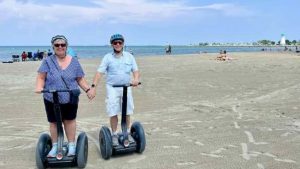The Best Cenotes of the Riviera Maya
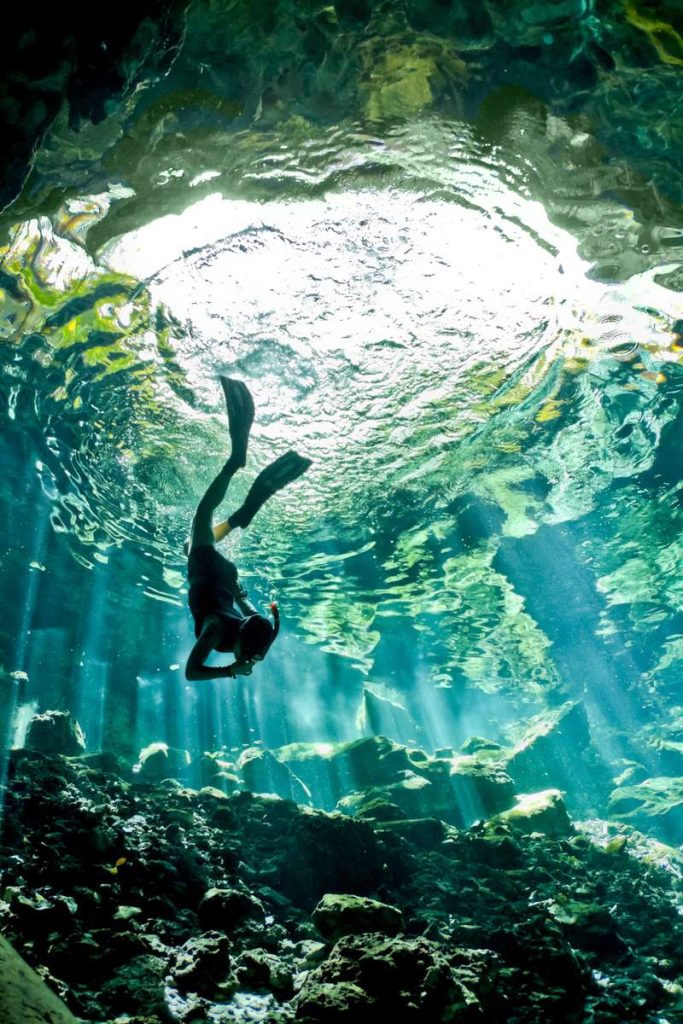
Advertisement: Click here to learn how to Generate Art From Text
Last updated:
There’s no denying that the Riviera Maya, spanning from the popular beaches of Cancun down to Playa Del Carmen and all the way to the gorgeous white sands of Tulum, includes some of the best sand and ocean views in continental North America.
What you may not realize is the Riviera Maya and Mexico’s Yucatan peninsula itself also contain dense jungles and some of the best cenotes you’ll find anywhere in the world.
What’s a cenote?
The Mayan Riviera is covered with limestone bedrock. Over time, these porous areas of rock have formed underground rivers. These freshwater underground river caverns are usually crystal clear as the limestone filters out the water.
Many of these caves have eventually collapsed, allowing them to be explored. Cenotes are limestone sinkholes. There are literally thousands in this region of Mexico, and new ones are still being discovered today.
What this means for you, is that no matter where you go in the Mayan Riviera, you’ll likely find one of these inviting cenotes to spend your day. Whether you’re there just to swim, jump off the surrounding cliffs or even there to go snorkelling and scuba diving in, cenotes offer a great way to explore the Riviera Maya’s hidden world away from the beach.
From the Mayan word “dzonot”The following are some examples of how to use “tsonot,”What it essentially means is “well” in English, cenotes (pronounced “say-no-tays”The region also has a rich history. Cenotes were vital to the ancient Mayans, who realized that they could provide enough water to sustain entire villages. Even larger ancient cities such as Chichen Itza depended on cenotes for survival.
Over the years, everything from gold and jade to beautiful mother of pearl jewelry has been found. The bones of ancient Mayan sacrifices were also discovered to ensure a prosperous season. While the sacred pools remain closed and have been preserved, the rest of the Riviera Maya’s cenotes are open for visitors.
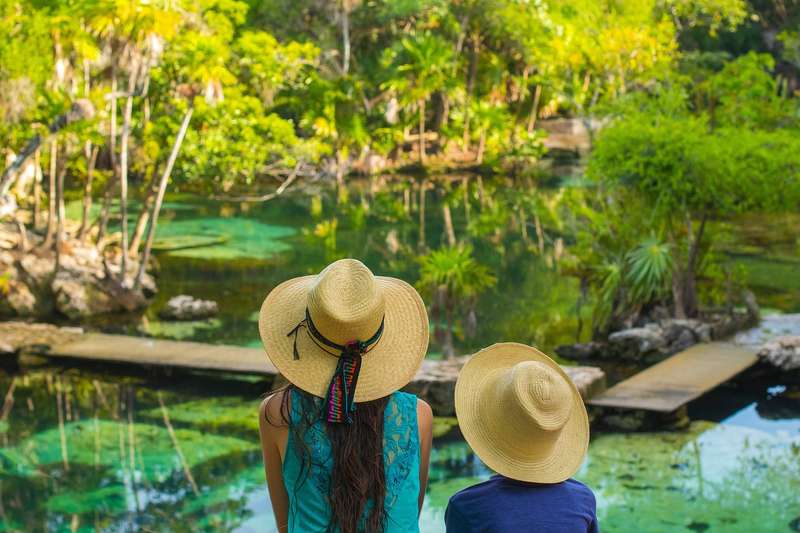
Cenotes in Riviera Cana: Types and Locations
There are four main types of cenotes in Riviera Maya. Cenotes can be classified as open air, semi-open, cave or partially closed cenotes or underground cenotes.
Open air cenotes are similar to small lakes or ponds, with most of the water being easily accessible. Though they can often have steep sides, they’re fairly common to find and offer ease of access vs the other cenote styles. These cenotes are ideal for families because everything is right in front of you and access to water is the easiest.
Semi-open cenotes have rocky overhangs. A good portion of a cenote can be considered open air, with some corners partially blocked from the skies. The cenotes tend to have darker areas, which are great for snorkeling. Generally they’re fine for families as well.
Cenotes with a hole to the ceiling are usually cave cenotes. The water is usually darker and you may need to use a ladder to reach the water. Not recommended for smaller children, they probably feature some of the best high diving you’ll find if you’re an adventure seeker.
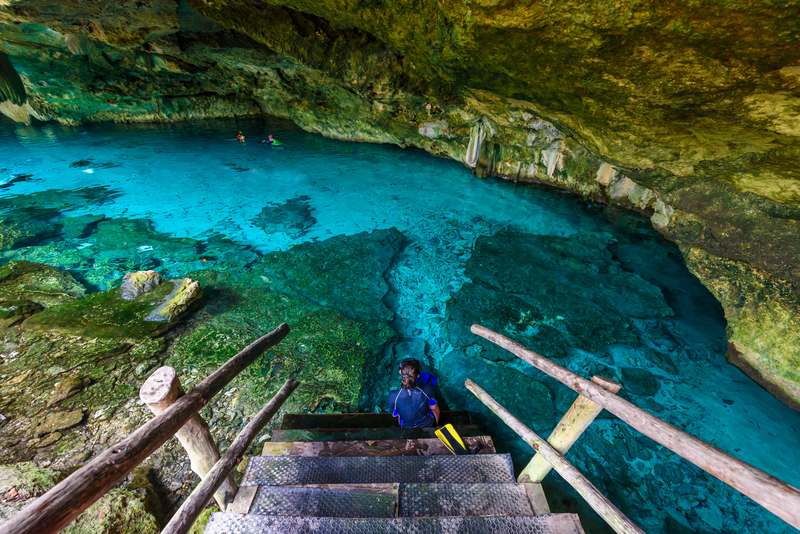
Cenotes underground are exactly what they sound like. These flooded Cenotes are only accessible by scuba-diving and only with the help of a knowledgeable guide. Also, only recommended for cavers who are experts.
Why visit a cenote on the Riviera Maya?
While sun and sand make for a great vacation, sometimes it’s nice to check out something new. With cenotes found near most of the major areas in Mexico’s Riviera Maya, getting to one often only takes a short trip. Some are near popular archives or make for a great stop while visiting other areas on the peninsula.
If exploring crystal-clear, freshwater swimming pools in a naturally created limestone setting sounds like the perfect day away from salt and sand, read on to find out about the best cenotes along the Riviera Maya.
Cenote Cristalino
Cenote Cristalino is one of the first cenotes our family ever explored in Mexico’s Yucatan peninsula. Interestingly, Cenote CristalinoThis is one of the very first cenotes posts we ever published on this website back in 2010. It still holds a very special place in our heart.
Just a stones throw away from Playa Del Carmen (10 km south of Playacar proper) and an easy taxi ride to get there, it’s not as popular as some of the bigger cenotes on this list however we’ve always enjoyed the times we’ve visited it. Almost across the road from Barcelo Maya Beach All Inclusive, it’s few open clear water pools complete with nibbling minnows make it an inviting cenote to visit.
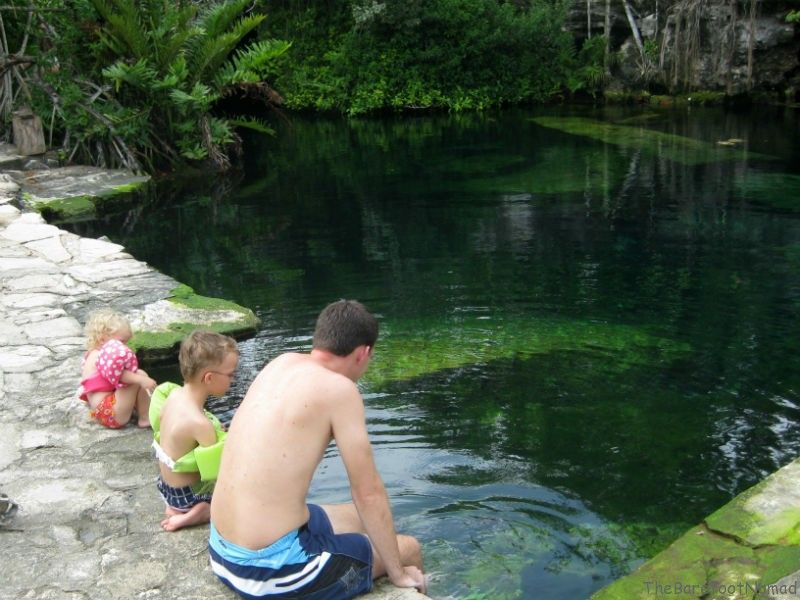
It’s also less touristy than many of this list as the area is less developed. The last time we were there a few years ago, it also hadn’t been bought out by a bigger company so it still maintains a rustic charm. On site, you can buy snacks and use the changing rooms. There’s a small daily fee to get in.
Cenote Azul
Cenote Azul offers a relaxing and fun day for families. Its shallow sections are ideal for children while the deeper sections are great for snorkelers and swimmers. For the more adventurous, there are a number of rock formations that can be used to jump off.
It is located within walking distance of Cenote Cristalino and offers additional services, such as showers, restrooms, and more. There is a small fee to use the services there however it’s only a 10 minute ride from Playa Del Carmen so makes for an easy getaway if you’re staying in the region.
Cenote Dos Ojos
Cenote Dos Ojos is one of the most famous cenotes on the Yucatan Peninsula. “Two Eyes Cenote,”Two connected sinkholes that resemble a pair eyes. Its crystal clear waters and extensive cave system make this a paradise for divers and snorkelers. The light coming through the cave openings creates a magical atmosphere that is perfect for underwater photography.
The day we went to Cenote Dos OjosWe saw many more swimmers than divers. Since the water in this luminescent blue cenote can be quite deep, it’s definitely not geared towards younger families though ours were fine with the lifejackets we brought that day and the cave portion is quite cool to see.
There are lockers, changing rooms, bathrooms and a restaurant. The site is more geared towards divers than swimmers. Cenote Dos ojos is located approximately 22km (13miles) north of Tulum along Carretera 307
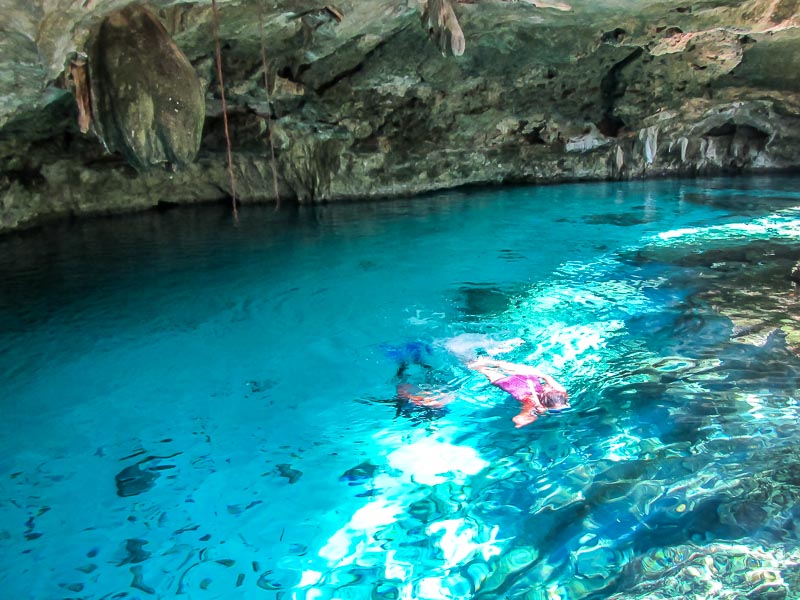
Gran Cenote
Gran Cenote, a semi-open Cenote surrounded by lush vegetation, is only a 10-minute drive up QROO 109 from Tulum. Turtles and small fish live in its turquoise water, making it a great place for snorkeling. The pool is easily accessible via a number of wooden platforms and steps.
While it’s much quieter than Doj Ojos, Gran Cenote is a bit more friendly towards families and is a quick trip from Tulum. Many cenotes have sand on the bottom and open caves that you can swim into. While you can’t stay right by the water, you can spread out above the cenote area. Gran Cenote is a large cenote.
The turtles and the proximity of Tulum to Gran Cenote are two of its biggest attractions. There are lockers, showers, bathrooms and hammocks available. The day fees at Gran Cenote range from 200 pesos to 300 pesos.
Cenote Zacil Ha
Cenote Zacil Ha can be found just down the street from Gran Cenote. It is a favorite cenote for those staying in Tulum. Cenote Zacil Ha is a cenote with a lot of open space and even a zipline to access the long pool.
Cenote Zacil Ha is a great, and cheap, place to cool off after visiting the popular Coba archaeological site. It is a great place to refresh yourself for less than 100 pesos.
Cenote Aktun-Ha
Cenote Aktun Ha is another cenote near Tulum, and only a few hundred metres from Cenote Zacil Ha.“water cave”() is a large open-air cenote in Riviera Cana. Cenote Carwash was also its nickname as local taxi drivers used the water for washing their vehicles.
With plenty of turtles and fish in the cenote, it has a maximum depth of around 18m or 60ft so you’ll see the occasional diver down below as well. There are changing rooms, restrooms and platforms to get into the water. It also has a 10ft (3.2M) diving platform
Cenote Ik Kil
Located near the very cool and popular Chichén Itzá, Cenote Ik Kil is an open-air cenote with dramatic vine-covered cliffs and cascading waterfalls. The circular shape, and the roots hanging down to the surface of the water, give this cenote an ethereal feel.
It’s a popular spot, so consider visiting early in the morning to avoid crowds or stay for a few days at one of the cabins on site. Cenote Ik Kil is equipped with bathrooms, change rooms, and a restaurant. Prices for adults are 100 Pesos and 50 Pesos for children.

Cenote Zací
While not in Riviera Maya itself, located in the heart of Valladolid, Cenote Zací is a semi-open cenote that offers a convenient break from city exploration. The massive open cave has a small island in the middle, with lush vegetation. Its waters are home to rare black fish without eyes. The restaurant on site offers a unique dining opportunity with views of the cenote.
Located between Cancun and Chichen Itza, Cenote Zaci is also a great stop if you’re exploring the ruins that day and want to cool off before driving the rest of the way back to Cancun. Though the waters in this cenote aren’t the clearest, swimming in the giant cavern of Cenote Zaci is an unforgettable experience. There are changing rooms, bathrooms and a small restaurant on the premises. Prices for adults range from 60 pesos to 30 pesos.
Cenote Escondido (Mayan Blue) and Cenote Cristal
Cenote Cristal and Cenote Escondido are two large cenotes that are open to the air, close to Tulum. Both cenotes are located in jungle settings and have cliff jumps (12ft or four meters) as well as a rope swing.
Both cenotes are owned by the same firm and are located next to eachother. Both cenotes have ample parking, restrooms, showers, and changing rooms. Entry to each cenote costs 150 Pesos. Cenote Cristal is more popular than Cenote Escondido. With more area to explore, Cenote Escondido is bigger, and almost feels like you’re swimming in a river than a typical cenote.
Cenotes in Riviera Cana: Tips for visiting them
- Bring Eco-Friendly sunscreen:Biodegradable sunscreen is the best way to protect cenote ecosystems. Many cenote owners, however, strongly discourage using any sunscreen.
- Wear Water ShoesWater shoes can protect your feet from cenotes that have rocky floors.
- Bring Mask and Snorkel Many sites rent snorkels, but the quality is often questionable and the cost per use can quickly add up. Bring your own. Leave the flippers home if you have limited space in your bag.
- Respect the EnvironmentKeep the cenotes pristine by not leaving behind any trash. Each cenote has a delicate eco-system and is a natural wonderland. When visiting, make sure to leave as little of a footprint as possible.
- Check for Entrance fees:Cenotes usually charge an entrance fee to cover maintenance and preservation.
- Make sure you don’t get scammed:Cenotes that charge 150 pesos per adult are the most expensive, but many cenotes only charge 50 or 60 pesos per person.
- Leave valuables behind: Theft of small items is a problem in certain cenotes. Leave your valuables at the hotel or rent a locker on site if you have things you don’t want walking away.
- Extra costs for cameras, drones and other devices: Several companies have decided to charge a surcharge for people who bring expensive cameras or drones into their facility. Depending on the cenote the cost can be equal to the entrance fee. If you don’t need it, leave it behind.

Whether you’re an avid cave diver, a snorkeling enthusiast, a cliff jumper or simply looking for a picturesque spot to relax, the cenotes of the Riviera Maya offer something for everyone. Each cenote has its unique charm, inviting visitors to explore the hidden treasures of the Yucatan’s underground world.
With something unique to see at each cenote, from stalactites and stalagmites to colorful turtles and even more colorful fish, you’ll never get a chance to experience such a large array of cenotes anywhere else on the planet.
We’ve written dozens of articles about MexicoOver the years, the Riviera Maya has been a popular destination. Playa Del CarmenIt is our second home.

‘ Credit:
Original content by www.thebarefootnomad.com – “The Best Cenotes in the Riviera Maya”
Read the complete article at https://www.thebarefootnomad.com/mexico/the-best-cenotes-in-the-riviera-maya/
